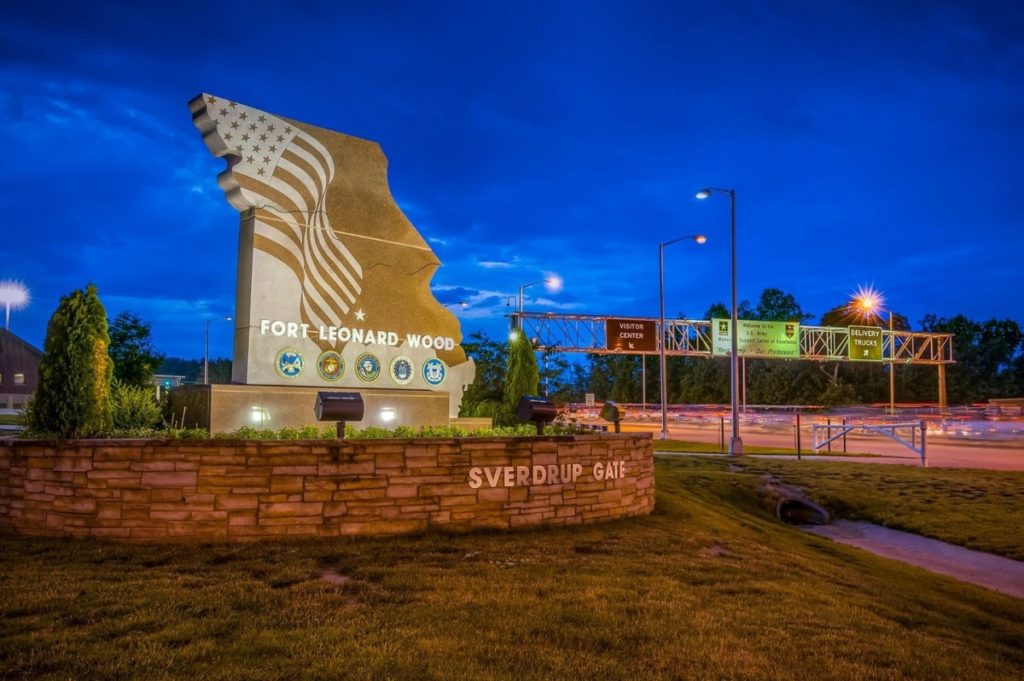Brian Hill
FORT LEONARD WOOD, Mo. (Nov. 13, 2019) – Reid Stephens, a 95-year-old WWII veteran of the Battle of the Bulge and prisoner of war in Germany, was honored Monday by the government of Belgium at a Veterans Day event in his hometown of Bourbon, Missouri — about halfway between Fort Leonard Wood and St. Louis.
The event, at Bourbon High School, was attended by Belgian Honorary Consul Marc Vanacht and Col. Eric Towns, U.S. Army Garrison Fort Leonard Wood commander, who spoke on the importance of making the sacrifices of all veterans matter.
“Mr. Stephens, it’s an honor to share the stage with you today,” Towns said. “While many of our veterans have fought on the front lines of famous battlefields … every single veteran, from machine gunners to mechanics, from cooks to code breakers, from paralegals to parachutists, have played an important role in defending our country and strengthening our nation. All of us in the room have people who have sacrificed things for us. I would urge you to make those sacrifices matter.”
Before introducing Vanacht, J.D. Huitt, Bourbon High School Social Studies teacher and master of ceremonies for the event, reminded the more than 200 students and faculty members in attendance that the freedoms enjoyed by Americans come with a price.
“I know it’s cliché to say now, but freedom is not free,” Huitt said. “Your freedom and mine have come at a cost. It’s been paid for by the service men and women and their families. It’s been paid for in bloodshed on the soils of countries that they do not call home — and in the most extreme cases, it’s been paid for with their own lives.”
After detailing the battles in which Stephens’ fought, Vanacht read a message from the Belgian ambassador to the U.S., Dirk Wouters.
“On the celebration this year of the 75th Anniversary of the Battle of the Bulge, we commemorate the immense sacrifice of American Soldiers, and the sacrifice of their loved ones,” he said. “The millions of people who live and prosper today in a free and democratic Europe owe a lot to them.”
Vanacht then thanked Stephens on behalf of the Kingdom of Belgium.
“The people of Belgium appreciate your heroism,” he said. “It was you and your brothers in arms who allowed the Allied generals first to resist in Bastogne and consolidate the front, then on Dec. 26 re-take the initiative that led to final victory in Europe less than six months later.”
Stephens was born in Hinch, Missouri, and went to high school in Bourbon when the town had a population of just 360 in the early 1940s.
“I knew what was coming because World War II had already started,” he said. “We were hit pretty hard in World War II. (My hometown) had 20-some funerals when they started bringing some of those boys back. I knew that eventually they were going to draft me.”
Stephens received his draft notice in March 1943, was inducted at Jefferson Barracks in St. Louis, and attended basic training at Camp Butner, North Carolina. After his training, he served as a machine gunner in Company B, 23rd Armored Infantry Battalion, 7th Armored Division. He was part of the Allied advance from Paris to Germany in the closing year of the war.
When the Germans launched their final counteroffensive through the densely-forested Ardennes region of eastern Belgium, northeast France and Luxembourg — commonly referred to as the Battle of the Bulge — on Dec. 16, 1944, Stephens travelled with the 7th Armored Division to defend the city of St. Vith, Belgium, which was a vital road junction for supply lines.
“They called us at about eight o’clock (that evening) and they said pack and get ready to move,” he said. “We rode the rest of the night and we were out at the edge of the village the next morning.”
The German surprise attack was successful, and American forces suffered their highest casualty rate in that campaign than any other during the war, according to historian Stephen Ambrose. When the threat of being overrun in St. Vith became imminent, Stephens’ platoon was tasked with providing rear-guard security while the rest of the company withdrew.
“Our platoon got caught left holding the bag,” he said. “Whenever an outfit withdrew, somebody had to stay and cover for their withdrawal, then you get a new line set up and then you get some extra artillery and so on, and you try to get your men back — but there was no extra artillery to be had.”
Stephens can still recall the conversation between his platoon leader and the company commander, Capt. Dudley Britton.
“Our platoon leader said, ‘Dud, what are we gonna do if we can’t hold ’em?’ (Britton) said, ‘Lieutenant, our orders are to hold.’ And that’s what we did; we held, but we paid the price,” Stephens said.
With little water and no food, Stephens’ platoon held their position against the advancing German Army for as long as they could, but they were surrounded. And although the Germans were successful in capturing St. Vith, their counteroffensive timetable was slowed considerably. By Dec. 26, 1944, the German offensive was essentially broken. The battle continued for another month before Allied lines were restored to their positions prior to the attack.
But for Stephens and the remaining dozen or so Soldiers who survived in St. Vith, the next four and a half months would be spent marching from one side of Germany to the other as prisoners of war.
“They started questioning us,” Stephens recalled. “This German officer could speak good English. So many of them could speak good English. They were tough. They were good soldiers.”
Stephens said they stopped in Cologne for some time.
“We crossed the Rhine River on the Remagen Bridge and there was a dud bomb that had put a big hole in it and they were guiding us around that hole.”
Stephens spent time at Stalag 12A — a German prisoner of war camp near Limburg, Germany — then was marched about 50 miles to Mühlberg. From there, he was forced to walk hundreds of miles to the outskirts of Berlin before arriving in Stargard (now in northwest Poland).
“Then the Russians started coming in and they were getting too close so they turned us around and we started walking back,” he said.
Eventually, the group was brought to Stalag 10B near the North Sea in northern Germany.
“They had barracks in there with barbed wire around them,” he said. “They had regular barracks but there was nothing in them — cold water and that was it.”
Stephens recalled that there was little to eat in the prison camps.
“They called it grass soup. I don’t know what was in it — different kinds of green stuff,” he said. “We’d get an old can of that. Once in a while we’d get a rutabaga soup.”
Once a week the prisoners would get a loaf of bread to divide up between them.
“When you’re trying to divide up a loaf of bread to feed 12 hungry men, you better cut it pretty close,” he said.
Stephens was liberated on April 29, 1945.
“You always had hope, but you couldn’t be sure what those guards were going to do,” he said. “I often wonder how come they didn’t just kill us and get rid of us, because they sometimes weren’t taking any prisoners — we found the effects of that.”
Stephens said that due to all the marching and lack of food, his weight dropped from 165 pounds to 112 pounds by the time he was liberated. He chalks up his survival mostly to determination.
“I’m gonna make it,” he said he’d told himself repeatedly over there.
Stephens’ homecoming was a complete surprise to his family.
“I never got a chance to call,” he said. “I was home knocking on the door before they even knew I was back in the United States. It’s unbelievable. They knew I was alive. They knew I’d survived, but they were surprised when they came to the door.”
Veterans of the Battle of the Bulge will be honored in December at sites across Belgium, The Netherlands and Luxembourg, on the occasion of the 75th Anniversary of the campaign.
(Editor’s note: Stephens’ quotes come from a series of video interviews conducted five years ago with J.D. Huitt. They can be found on the YouTube page, The History Underground.)

-30-
About Fort Leonard Wood
Fort Leonard Wood is a thriving and prosperous installation that has evolved from a small basic training post more than 75 years ago to a premier Army Center of Excellence that trains more than 80,000 military and civilians each year.
Fort Leonard Wood is home to the U.S Army Maneuver Support Center of Excellence and three U.S. Army schools: the U.S. Army Engineer School; U.S. Army Chemical, Biological, Radiological and Nuclear School; and the U.S. Army Military Police School. In addition to training engineer, CBRN and military police specialties for the Army, Fort Leonard Wood also provides gender-integrated in-processing and Basic Combat Training for new Soldiers.
Fort Leonard Wood also hosts and trains with the largest Marine Corps Detachment and Air Force Squadron on any Army installation as well as a large Navy construction detachment.
More information about Fort Leonard Wood is at: https://home.army.mil/wood/index.php/about/mission


